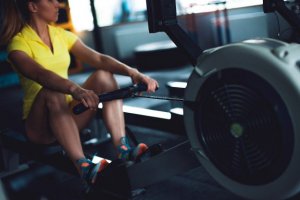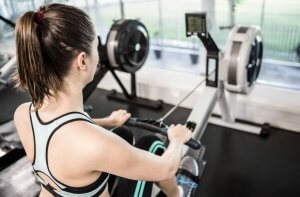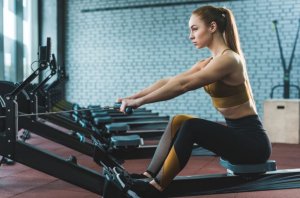12 Exercises to do on a Rowing Machine

It’s not a particularly popular machine at the gym, even though it works your shoulders, arms, and legs. Actually, many people don’t even know what it’s used for! That’s why in this article we’ll give you 12 of the best exercises to do on a rowing machine, to ensure that you can get the best from it.
Exercises with the rowing machine
Thanks to the rowing machine, you’ll work many of your muscles, burn fat and tone your arms, shoulders, back, and even your abs. Remember, keep your back straight throughout the routine and your elbows close to your body, except in the cases where you’re told differently. These are the best exercises:
1. Basic stroke
The technique is the same as if you were rowing in a boat. Maybe you’ve never actually rowed a boat, but you know what we’re talking about.
Firstly, stretch your legs and hold the belts. Flex and stretch your knees, and at the same time, bend and stretch your arms. Inhale as you extend your arms and exhale as you bring the belts close to your chest.
2. Back row
Start like in the other exercise, but in this case, when you stretch the belts, the idea is that your elbows go beyond your back. Your knuckles touch the sides of your torso, and your elbows are slightly out.
3. Shoulder lifts
Take the belts and stretch your arms to the front, when you push back with your legs, raise your arms until they’re above your head. You’ll mainly work the trapezius and deltoid muscles.
4. Internal grip
This rowing machine exercise is great for working your triceps. To do it, hold the belts from below so the palms of your hands are facing up. Your elbows stay against you at all times, and your knuckles touch your shoulders when you raise your arms.

5. Posterior extensions
In this case, you’ll sit with the belts behind you and your feet on each side of the rowing machine. Your elbows touch your ears, and your hands are at the same level as your head (to begin). Then, stretch your arms as if you were going to touch the ceiling with your fingers.
6. Chest traction
If you want to work your chest with this machine, lay down on it, with your head on the same side as the belts. Then, grab them stretching your arms above your chest; lower your arms until they’re at your sides. This exercise is similar to the bench press exercise.
7. Lay-down traction
This exercise is similar to the previous one, but, the way you’ll move your arms is different. Firstly, start in the same position and flex your elbows. Then, extend your arms, but only in the biceps area.
Remember, keep your back straight throughout the routine and your elbows close to your body, except in the cases where you’re told differently.
8. Lay upside down
Lay down with your flexed legs near the base of the belts. Grab the ends with both hands and bring the belts towards your chest. Your head must always be supported on the saddle.
9. Crunches
Believe it or not, you can also do crunches on the rowing machine. To do them, put your head on the saddle and do your usual routine. Do the exercises you’d usually do on a bench, such as leg lifts or crunches.
10. Knee traction
Work your trapezius and biceps, (each side separately). For this exercise, place your right knee on the saddle and the left knee on the floor. Hold the belt with your right arm, flex your elbow and take your arm to the back. Repeat 20 times and then change sides.

11. Crossed knees
This exercise works your chest, first on one side and then on the other. Sit on the saddle, then grab the belt with one arm and push to the other side. If you’re holding the belt with your right arm then take it to the left side.
12. Crossed knees with lifts
This exercise is similar to the previous one, but in this case, to work your deltoid muscles and trapezius, you have to stretch your arms backward. If you’re holding the belt with your right arm then take it from your bellybutton to your right shoulder.
As you were able to confirm, there are plenty of exercise options you can do with a rowing machine. You just need to let your imagination fly and take advantage of the resistance that the belts offer.
Finally, make sure you have a good technique, and always ask for the help of a trainer in charge.
It’s not a particularly popular machine at the gym, even though it works your shoulders, arms, and legs. Actually, many people don’t even know what it’s used for! That’s why in this article we’ll give you 12 of the best exercises to do on a rowing machine, to ensure that you can get the best from it.
Exercises with the rowing machine
Thanks to the rowing machine, you’ll work many of your muscles, burn fat and tone your arms, shoulders, back, and even your abs. Remember, keep your back straight throughout the routine and your elbows close to your body, except in the cases where you’re told differently. These are the best exercises:
1. Basic stroke
The technique is the same as if you were rowing in a boat. Maybe you’ve never actually rowed a boat, but you know what we’re talking about.
Firstly, stretch your legs and hold the belts. Flex and stretch your knees, and at the same time, bend and stretch your arms. Inhale as you extend your arms and exhale as you bring the belts close to your chest.
2. Back row
Start like in the other exercise, but in this case, when you stretch the belts, the idea is that your elbows go beyond your back. Your knuckles touch the sides of your torso, and your elbows are slightly out.
3. Shoulder lifts
Take the belts and stretch your arms to the front, when you push back with your legs, raise your arms until they’re above your head. You’ll mainly work the trapezius and deltoid muscles.
4. Internal grip
This rowing machine exercise is great for working your triceps. To do it, hold the belts from below so the palms of your hands are facing up. Your elbows stay against you at all times, and your knuckles touch your shoulders when you raise your arms.

5. Posterior extensions
In this case, you’ll sit with the belts behind you and your feet on each side of the rowing machine. Your elbows touch your ears, and your hands are at the same level as your head (to begin). Then, stretch your arms as if you were going to touch the ceiling with your fingers.
6. Chest traction
If you want to work your chest with this machine, lay down on it, with your head on the same side as the belts. Then, grab them stretching your arms above your chest; lower your arms until they’re at your sides. This exercise is similar to the bench press exercise.
7. Lay-down traction
This exercise is similar to the previous one, but, the way you’ll move your arms is different. Firstly, start in the same position and flex your elbows. Then, extend your arms, but only in the biceps area.
Remember, keep your back straight throughout the routine and your elbows close to your body, except in the cases where you’re told differently.
8. Lay upside down
Lay down with your flexed legs near the base of the belts. Grab the ends with both hands and bring the belts towards your chest. Your head must always be supported on the saddle.
9. Crunches
Believe it or not, you can also do crunches on the rowing machine. To do them, put your head on the saddle and do your usual routine. Do the exercises you’d usually do on a bench, such as leg lifts or crunches.
10. Knee traction
Work your trapezius and biceps, (each side separately). For this exercise, place your right knee on the saddle and the left knee on the floor. Hold the belt with your right arm, flex your elbow and take your arm to the back. Repeat 20 times and then change sides.

11. Crossed knees
This exercise works your chest, first on one side and then on the other. Sit on the saddle, then grab the belt with one arm and push to the other side. If you’re holding the belt with your right arm then take it to the left side.
12. Crossed knees with lifts
This exercise is similar to the previous one, but in this case, to work your deltoid muscles and trapezius, you have to stretch your arms backward. If you’re holding the belt with your right arm then take it from your bellybutton to your right shoulder.
As you were able to confirm, there are plenty of exercise options you can do with a rowing machine. You just need to let your imagination fly and take advantage of the resistance that the belts offer.
Finally, make sure you have a good technique, and always ask for the help of a trainer in charge.
All cited sources were thoroughly reviewed by our team to ensure their quality, reliability, currency, and validity. The bibliography of this article was considered reliable and of academic or scientific accuracy.
- Atkinson, Keith; Atkinson, Celia; O´Neill, Terry. Remo Indoor: Guía de entrenamiento. Federación Nacional de Remo. Disponible en: http://www.fnavremo.com/files//fnavremo/Documentos/Informacion/Remo%20Indoor.pdf
This text is provided for informational purposes only and does not replace consultation with a professional. If in doubt, consult your specialist.








